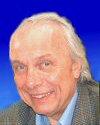Dr. Andrew Goldsworthy, MSc, PhD
Biography, Imperial College, London
Department of Biological Sciences

- Compact Fluorescent Lamps (CFLs) – What you need to know about low energy lighting
- The UK HPA have also expressed caution about compact fluorescent lighting
- Wifi in Schools, by Dr. Andrew Goldsworthy, November 2011
- The Biological Effects of Weak Electromagnetic Fields, April 2012
- Effects of Electromagnetic Fields on Glands and its Relationship with Diabetes, May 2012
- Dr. Goldsworthy also featured in an excellent interview with MCS America, the transcript of which is well worth the read.
- The Biological Effects of Weak Electromagnetic Fields
- The dangers of electrosmog, Andrew Goldsworthy, 2007
- The Biological Effects of Weak Electromagnetic Fields, Andrew Goldsworthy, 2007
- Goldsworthy A, 2006. ‘Effects of electrical and electromagnetic fields on plants and related topics’. In Plant Electrophysiology – Theory and Methods. Ed. Volkov A G (Springer, Berlin, Heidelberg, New York).
- Goldsworthy A, Whitney H, Morris E, 1999. ‘Biological effects of physically conditioned water’. Water Research. 33, 1618-1626.
- Goldsworthy A, 1996. ‘Electrostimulation of cells by weak electric currents’. In Electrical Manipulation of Cells. Eds. Lynch, P., Davey, M.R. (Chapman and Hall, New York).
- Goldsworthy A, 1995. ‘Photorespiration’. In Production and Improvement of Crops for Drylands. Ed. Gupta, U.S. (Oxford & IBH Publishing Co., New Delhi).
- Mina M G, Goldsworthy A, 1992. ‘Electrical polarization of tobacco cells by Ca2+ ion channels’. J. Exptl. Bot. 43, 449-454.
- Goldsworthy A, 1991. ‘The Phycobilins’. In Photoreceptor Evolution and Function, ed. Holmes, M.G. (Acad. Press, London).
- Mina M G, Goldsworthy A, 1991. Changes in the electrical polarity of tobacco cells following the application of weak external currents. Planta 186, 104-108.
- Goldsworthy A, Mina M G, 1991. Electrical patterns of tobacco cells tobacco cells in media containing indole-3-acetic acid or 2,4-dichlorophenoxyacetic acid. Planta 183, 368-373.
- Goldsworthy A, 1988. ‘Growth control in plant tissue cultures’. In Advances in Biotechnological Processes, Volume 9. Ed. Mizrahi A (Alan R Liss, New York).
- Goldsworthy A, 1987. Why trees are green. New Scientist 116 (1590), 48-52.
- Goldsworthy A, 1987. Why did nature select green plants? Nature 328, 207-208.
- Goldsworthy A, 1987. ‘Electrical control of growth in plant tissue cultures’. In Plant and Animal Cells: Process Possibilities. Eds. Webb, C. and Mavituna, F. (Ellis Horlwood, Chichester 1987).
- Goldsworthy A, 1986. The electric compass of plants. New Scientist 109 (1489), 22-23.
- Goldsworthy A, Rathore K S, 1985. Electrical control of shoot regeneration in plant tissue cultures. Bio/Technology 3, 1107-1109.
- Rathore K S, Goldsworthy A, 1985. Electrical control of growth in plant tissue cultures. Bio/Technology 3, 253-254.
- Goldsworthy A, 1984. The cell electric. New Scientist 102 (1407), 14-15.
- Goldsworthy A, 1983. The evolution of plant action potentials. J. Theor. Biol. 103, 645-648.
- Goldsworthy A, Fielding J L, Dover M B J, 1982. ‘Flash Imbibition’ a method for the re-invigoration of aged wheat seed. Seed Sci. & Technol. 10, 55-65.
- Goldsworthy A, 1978. An instrument for measuring crop density by light absorbance. Ann. Bot. 42, 1315-1325.
- Goldsworthy A, Gates R, Ridgley D L, 1977. An electronic coleoptile measuring device. J. Exptl. Bot. 28, 744-750
Related
Educational and Informational Purposes: All
information on this site and all links that are linked to from
StayOnTheTruth.com represent solely the opinions of their producers.
This
information and links to more information are made available to you as a
resource for your own research and evaluation not as an endorsement.
StayOnTheTruth.com
is not in the business of persuading you or anyone else to believe
anything that that is presented linked to from this site; however, it
does encourage you to use all available resources to form your own
judgement about very important things that affect your life.
Fair Dealing and Fair Use Notice:
The material on this site is provided for educational and informational
purposes. It may contain copyrighted material the use of which has not
always been specifically authorized by the copyright owner. It is being
made available in an effort to advance the understanding of scientific,
environmental, economic, social justice and human rights issues etc. It
is believed that this constitutes a 'fair dealing' or 'fair use' of any
such copyrighted material as provided for in copyright law. In
accordance with the Fair Dealing or Fair Use intention, the material on
this site is distributed without profit to those who have an interest in
using the included information for research and educational purposes.
If you wish to use copyrighted material from this site for purposes of
your own that go beyond 'fair dealing' or 'fair use', you must obtain
permission from the copyright owner. The information on this site does
not constitute legal or technical advice.
© Copyright 2025. All Rights Reserved. "Stay On The Truth", Dianne Knight
Landline Telephone
(416) 551-7259
Please Note:
Landline Telephone cannot receive a text message and without any notification if sent.
Mailing Address
Dianne Knight, B.A.
18-3555 Don Mills Rd.
Suite 157
North York, Ontario, Canada
M2H 3N3